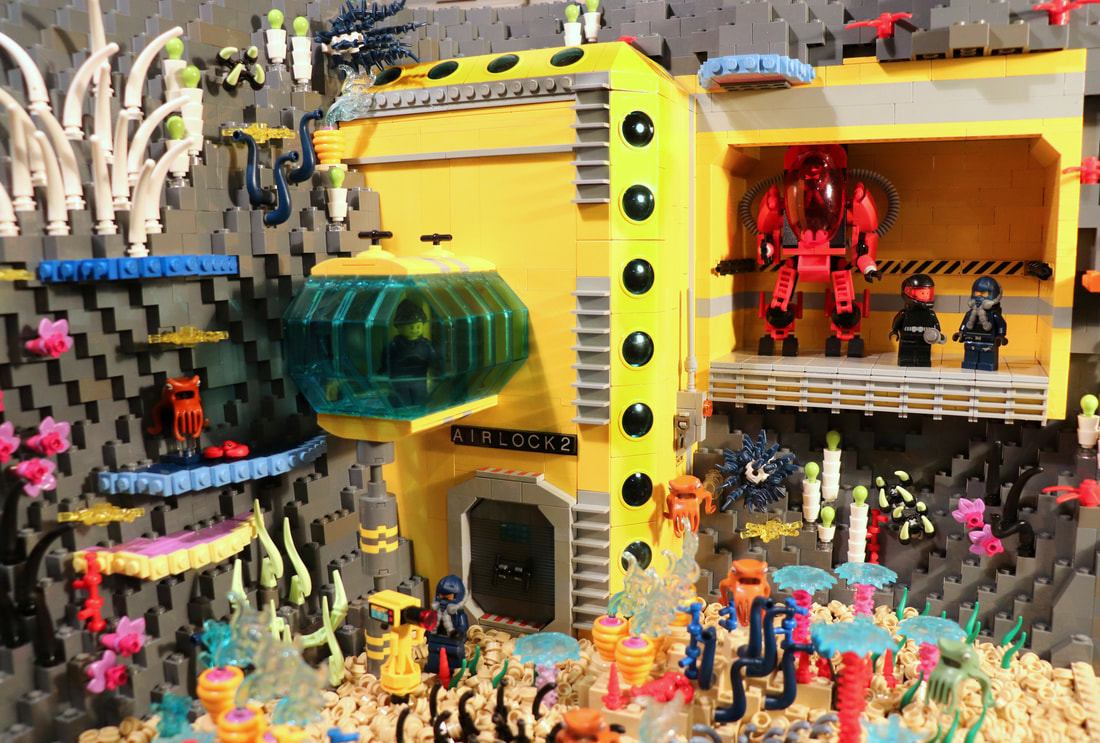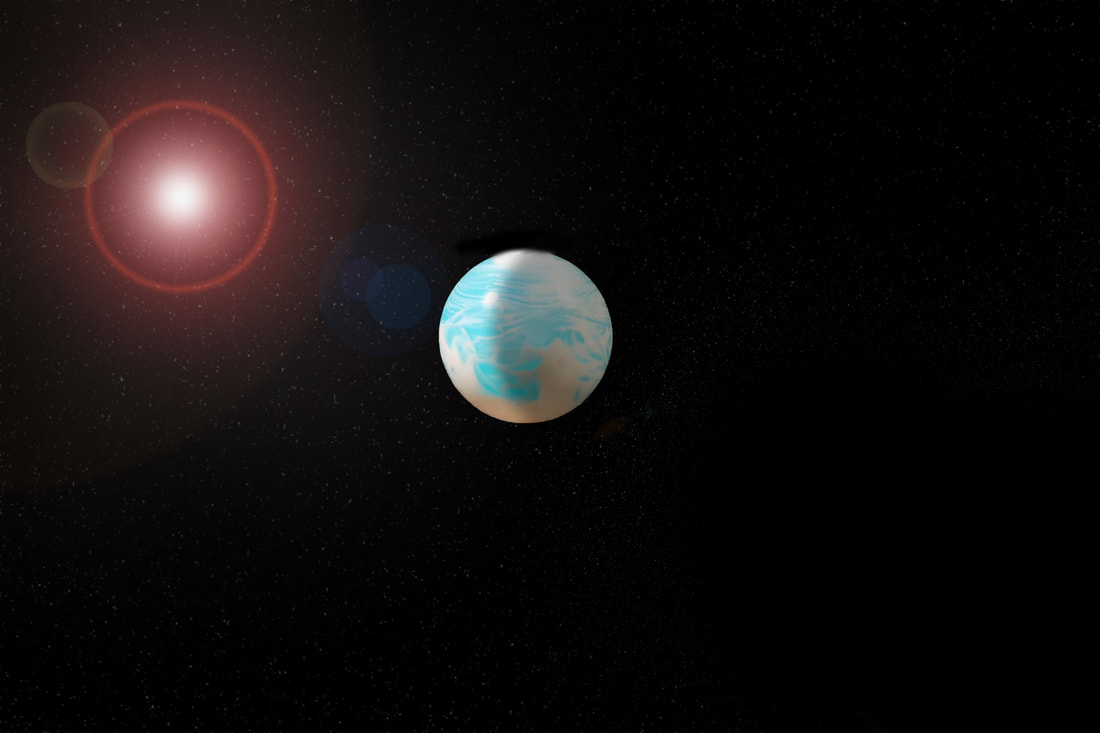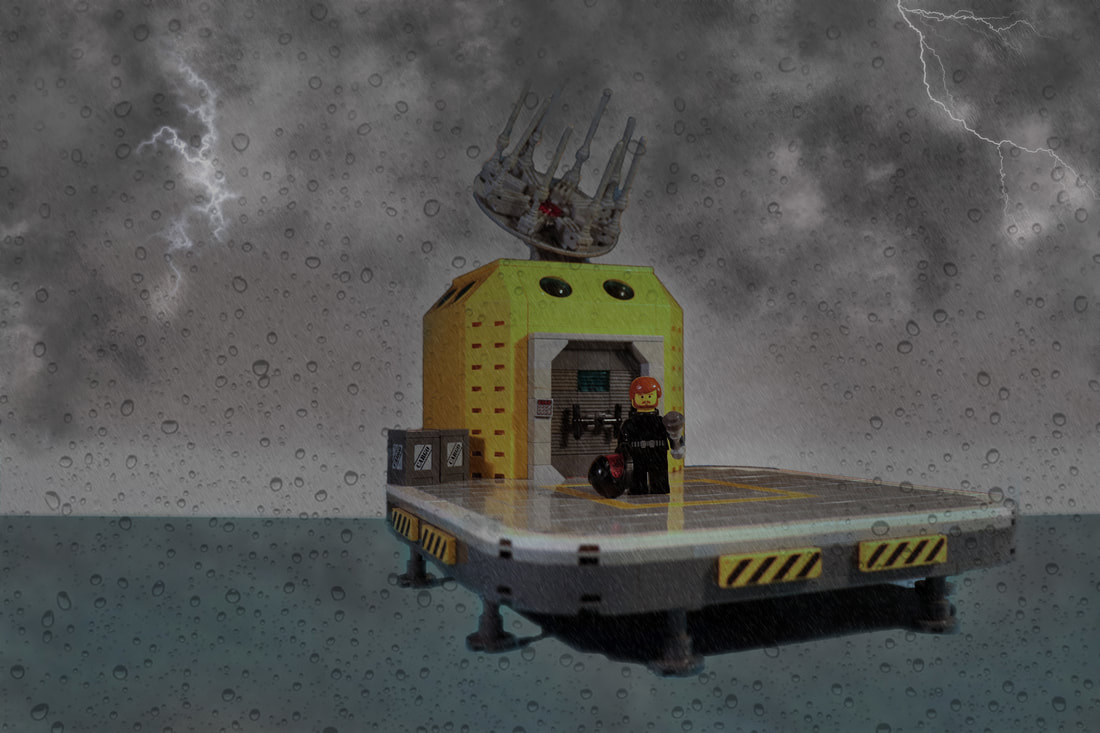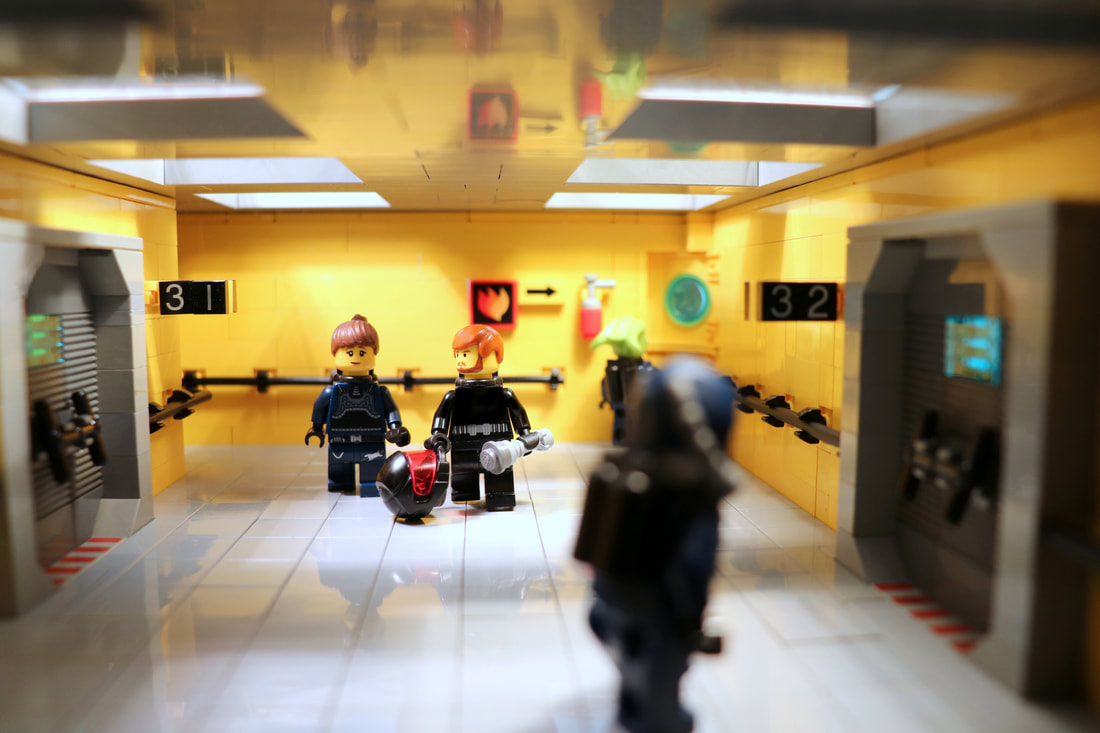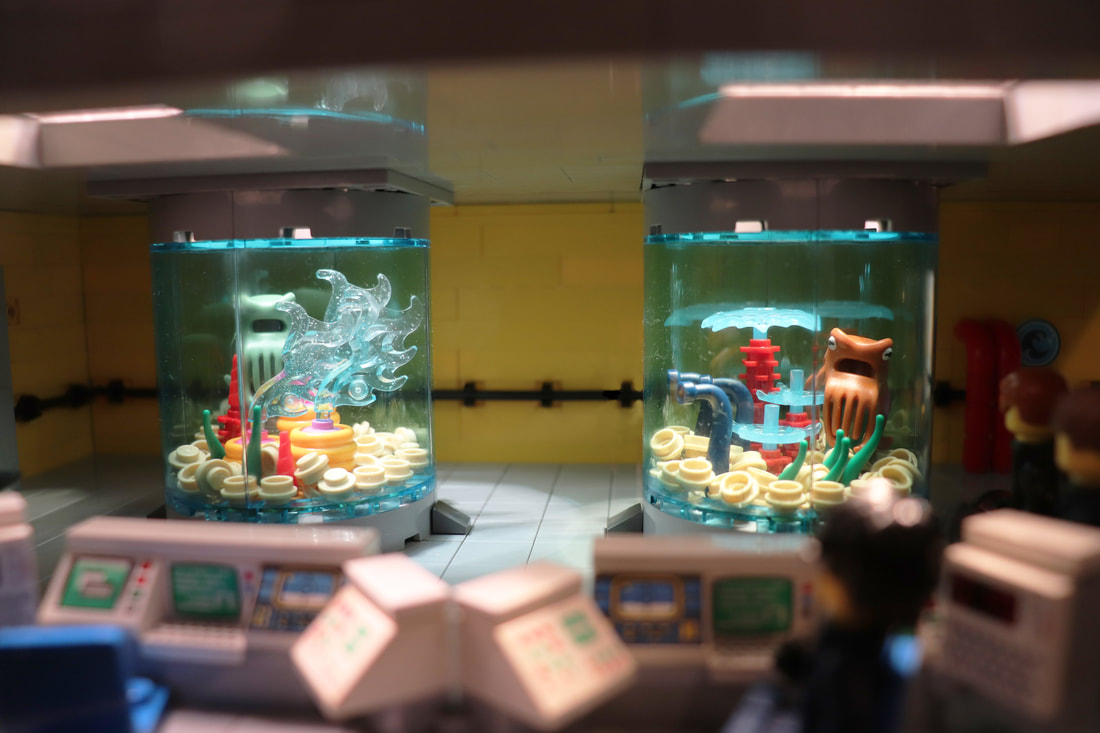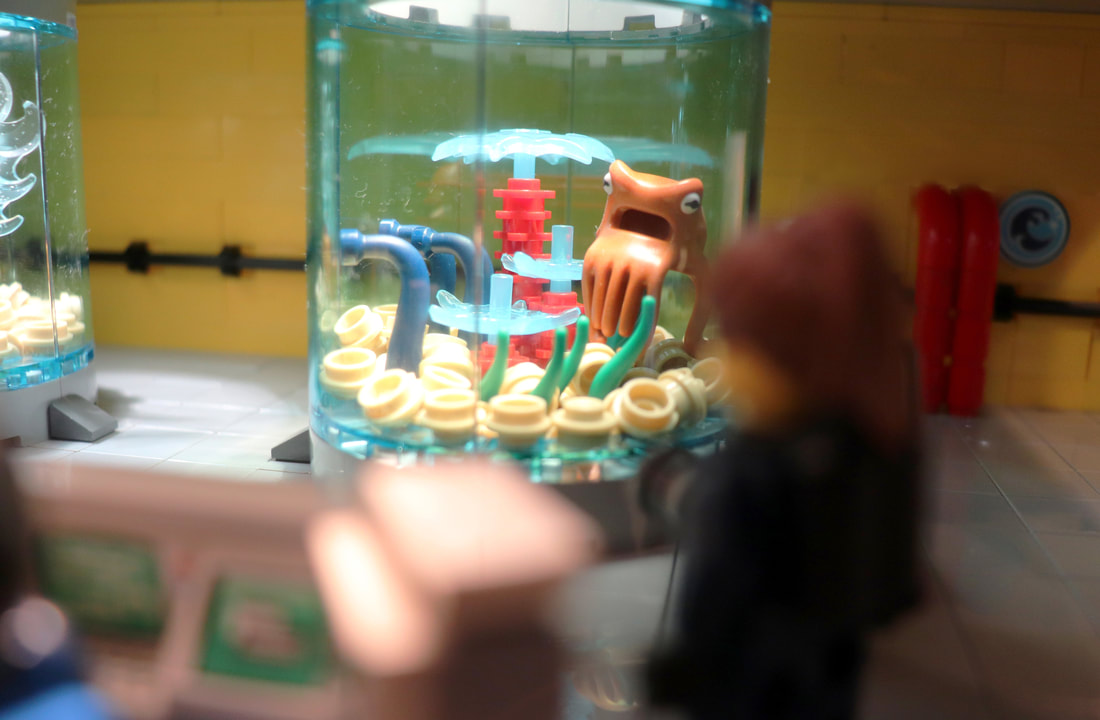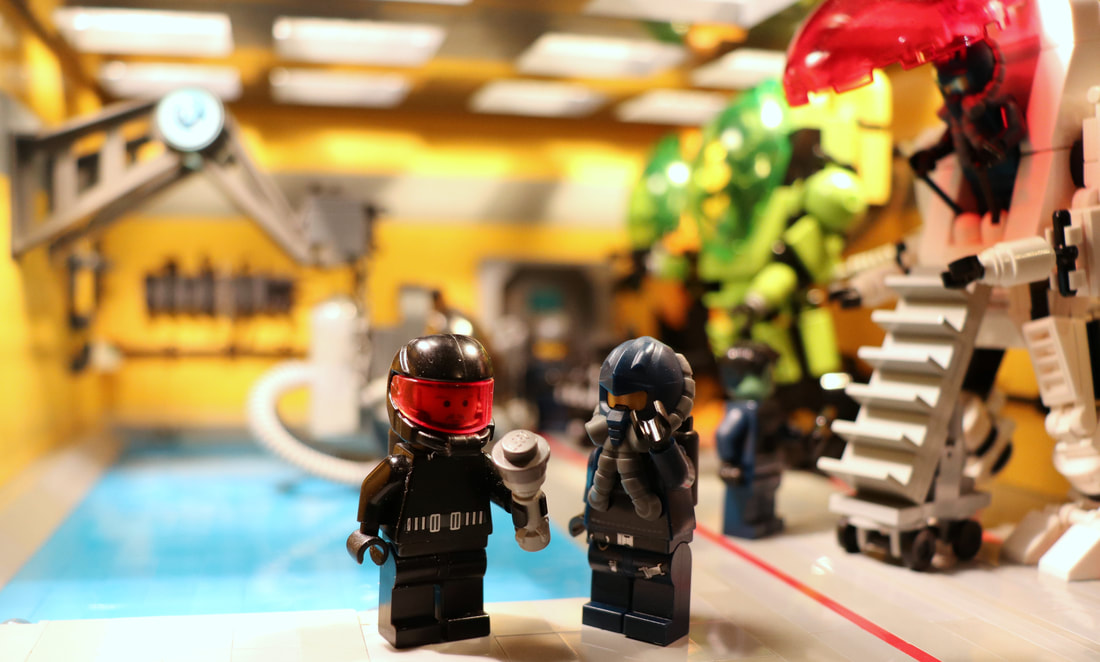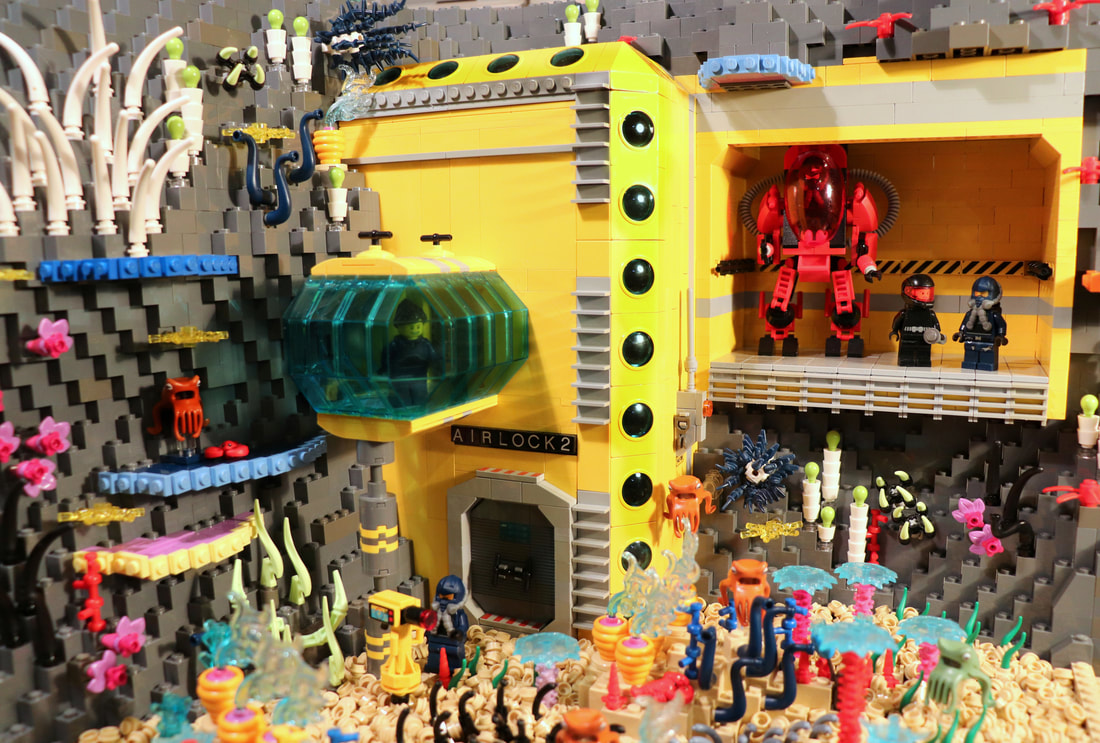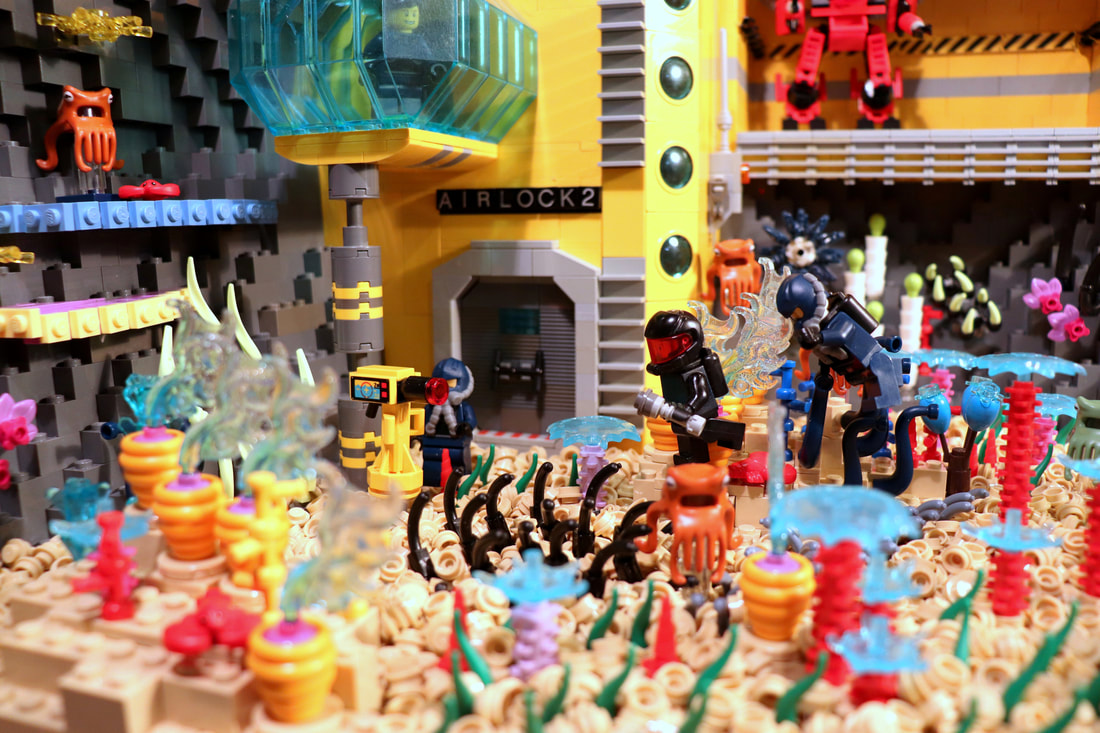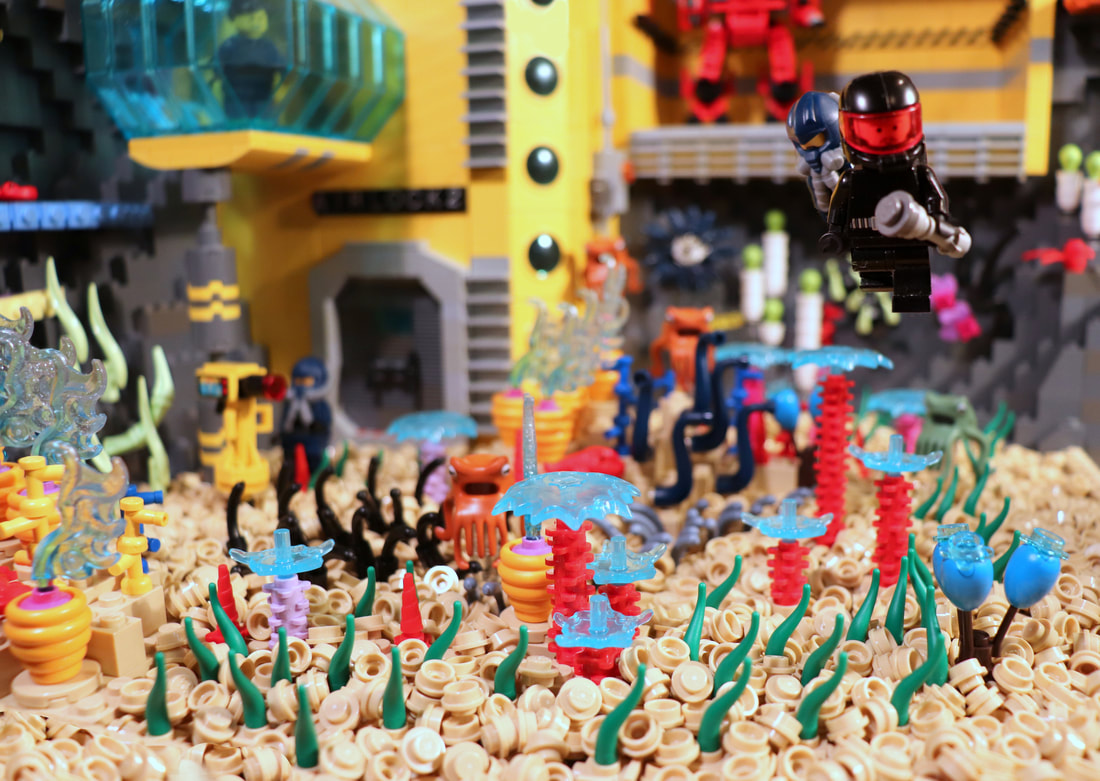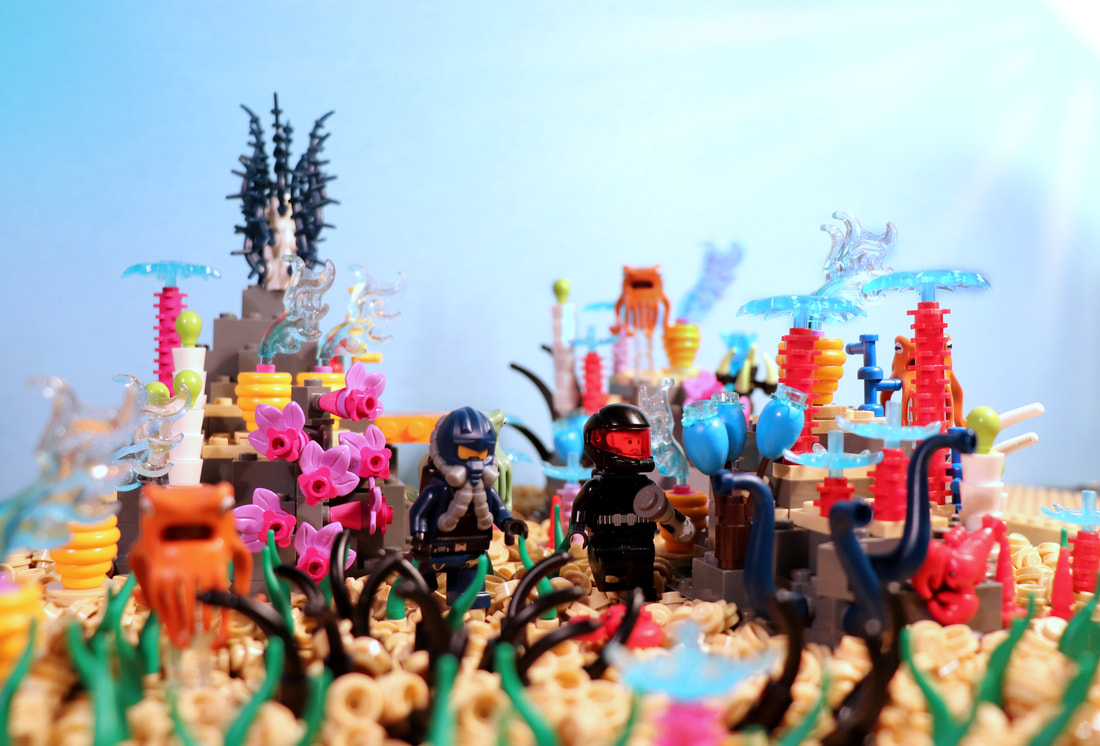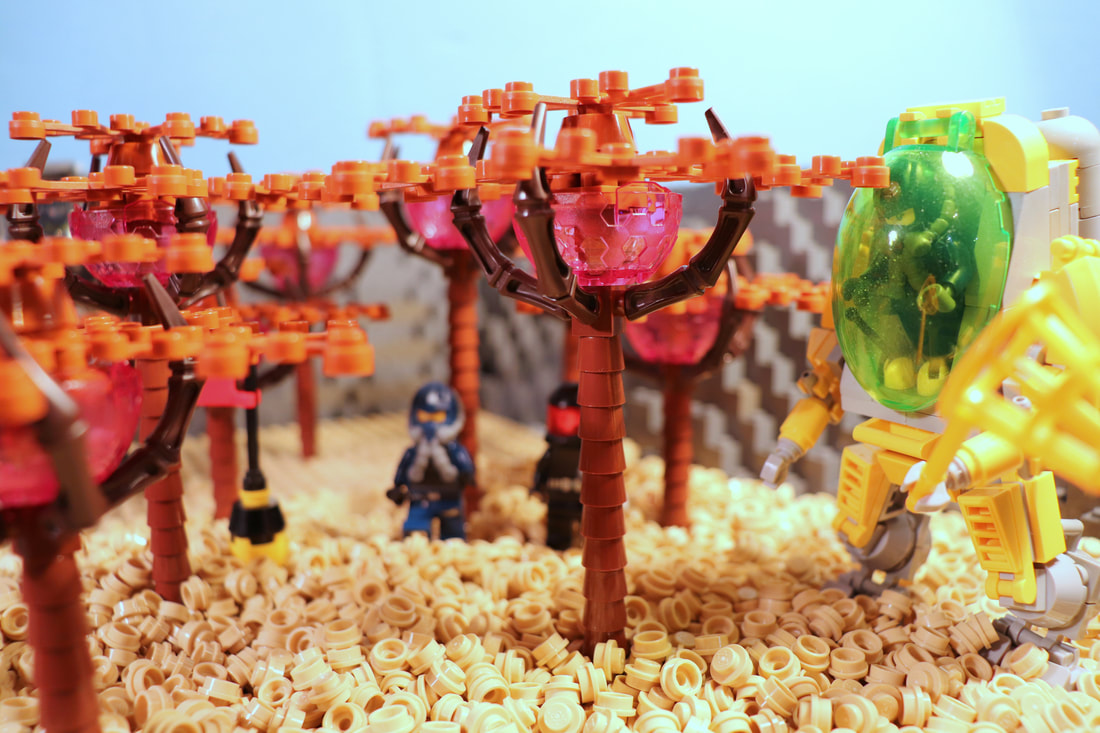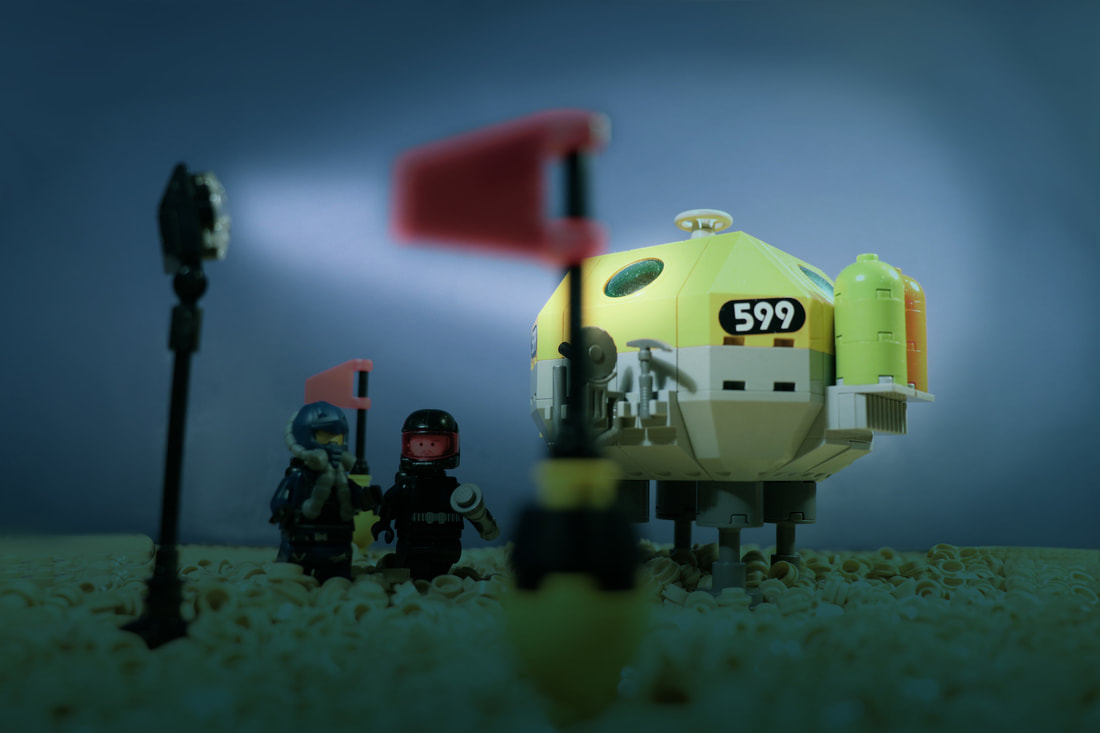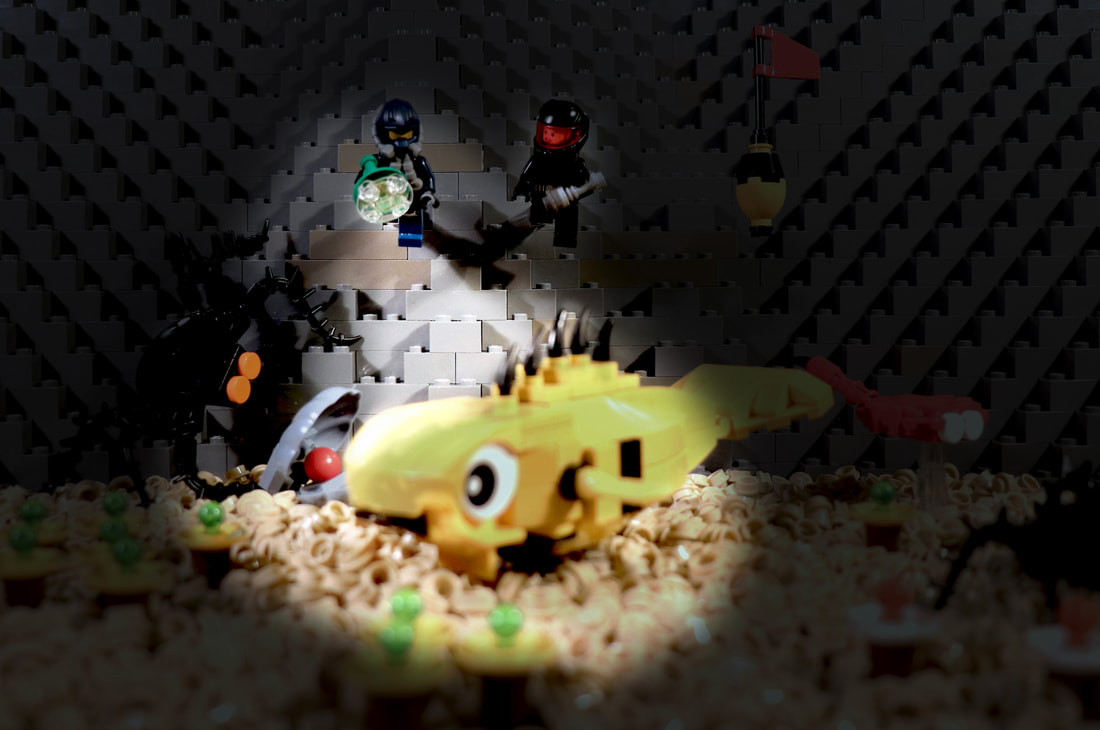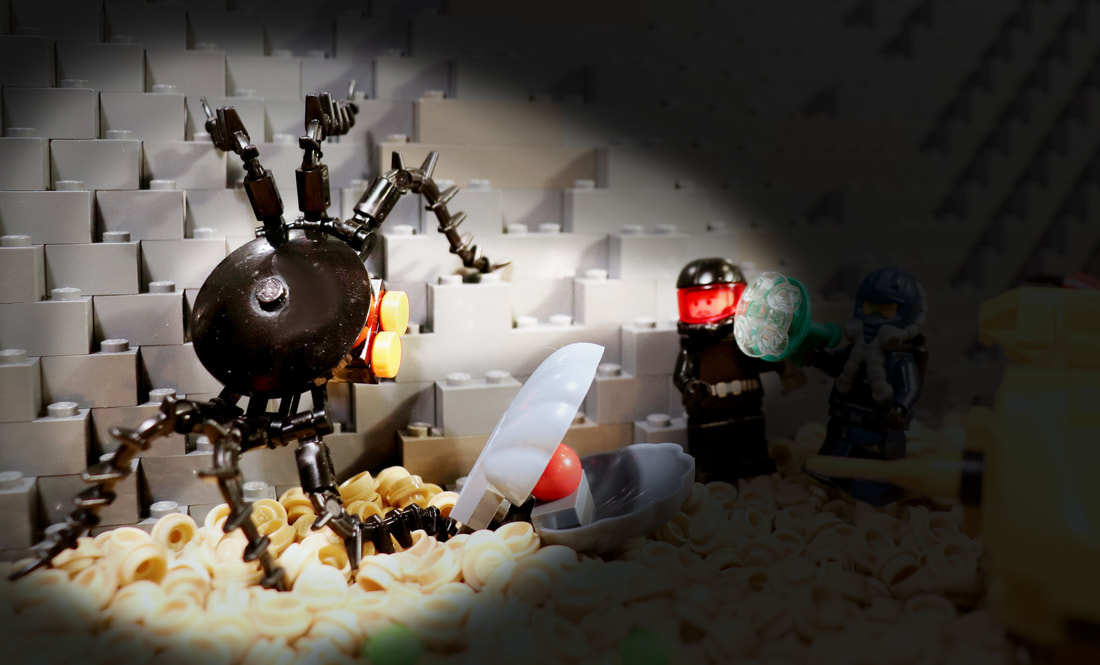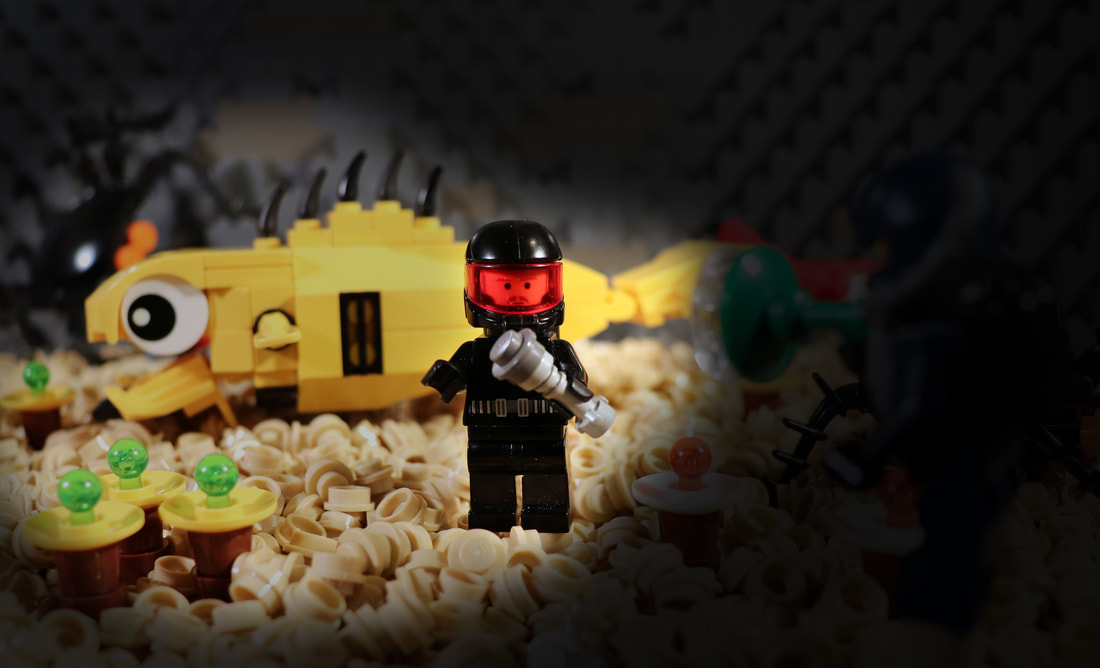There are billions of stars, millions of planets, but there is only one man, Terrance McDoogal. Welcome to LIU Atlas.
LIU Atlas - Nemus
The Ludgonian Industrial Union's galaxy contains billions of stars and billions of planets. Unfortunately, most residents of the LIU could only name a handful of these worlds. In order to improve astronomy grades across the LIU Galaxy, TV2 has started a new program called LIU Atlas. Follow our host, Terrance McDoogal, as he takes you on a tour across the LIU and some of its more obscure worlds.
Note: This episode is presented in full screen. The corresponding dialogue is underneath each photo.
Note: This episode is presented in full screen. The corresponding dialogue is underneath each photo.
Doog: “Welcome to another episode of LIU Atlas. I’m your host, Terrance “Doog” McDoogal. Today, we’re visiting the ocean world of Nemus. Nemus has no exposed landmasses. The entire world is covered in one large ocean. Occasionally, there’s ice masses near the planet’s winter pole, but they rarely survive the changing of the seasons. If there are any structures here, they’ll be underwater. Let’s head down and find out.”
Doog: “When you imagine an ocean world, you often think of a tropical paradise with blue skies and crystal-clear waters, but, most of the time, that’s not the case. Planets with this much water generate lots of clouds and lots of rain. As you can see, Nemus is no exception. It’s storming pretty hard right now. This landing platform is probably a lightning magnet, so I don’t want linger. I believe the building behind me is some type of elevator that leads to an underwater facility. Let’s head inside.”
Doog: “Whoa! Holy crap! You scared me. I wasn’t expecting anyone to be in here. Are you, like, an elevator attendant or something?”
Sylvia: “No, I’m Silvia, your guide.”
Doog: “Why are you just standing in an elevator?”
Sylvia: “Well, I was waiting on the landing platform until this storm rolled in.”
Doog: “Fair enough. So, where are we heading?”
Sylvia: “We’re descending to the Trident Research Station.”
Doog: “Research facility? So, you’re a researcher?”
Sylvia: “I am. I’m a marine biologist.”
Doog: “Biologist. That means you’re studying animals, right?”
Sylvia: “Correct. Nemus is home to an abundance of diverse life. We’re here studying it.”
Sylvia: “No, I’m Silvia, your guide.”
Doog: “Why are you just standing in an elevator?”
Sylvia: “Well, I was waiting on the landing platform until this storm rolled in.”
Doog: “Fair enough. So, where are we heading?”
Sylvia: “We’re descending to the Trident Research Station.”
Doog: “Research facility? So, you’re a researcher?”
Sylvia: “I am. I’m a marine biologist.”
Doog: “Biologist. That means you’re studying animals, right?”
Sylvia: “Correct. Nemus is home to an abundance of diverse life. We’re here studying it.”
Sylvia: “Welcome to Trident Station. This is the main level. It’s home to the dormitories and laboratories.”
Doog: “How deep underwater are we?”
Sylvia: “It depends on the storm surge and lunar tides, but you’re about twenty-five meters under the surface.”
Doog: “Yikes.”
Sylvia: “What?”
Doog: “I can do space and poisonous atmospheres all day, but there’s something about being underwater that makes me claustrophobic.”
Sylvia: “Being underwater can have that effect. It’s not for everyone. Don’t worry, though. I can assure you that Trident is one hundred percent safe. It’s been here a decade without any problems. Head into room thirty-two, on your left.”
Doog: “How deep underwater are we?”
Sylvia: “It depends on the storm surge and lunar tides, but you’re about twenty-five meters under the surface.”
Doog: “Yikes.”
Sylvia: “What?”
Doog: “I can do space and poisonous atmospheres all day, but there’s something about being underwater that makes me claustrophobic.”
Sylvia: “Being underwater can have that effect. It’s not for everyone. Don’t worry, though. I can assure you that Trident is one hundred percent safe. It’s been here a decade without any problems. Head into room thirty-two, on your left.”
Doog: “Wow, cool aquariums.”
Sylvia: “We prefer to call them artificial environment tubes, but, yeah, aquariums…more or less.”
Doog: “I don’t recognize most of the species in there, just the octopus.”
Sylvia: “A Septipus, actually. These are all species endemic to Nemus. You shouldn’t recognize any of them.”
Doog: “Septipus? Oh, I get it. It only has seven arms.”
Sylvia: “Yes. The differences don’t stop there. I could go on for days.”
Doog: “No need for that, because I could only listen for minutes.”
Sylvia: “We prefer to call them artificial environment tubes, but, yeah, aquariums…more or less.”
Doog: “I don’t recognize most of the species in there, just the octopus.”
Sylvia: “A Septipus, actually. These are all species endemic to Nemus. You shouldn’t recognize any of them.”
Doog: “Septipus? Oh, I get it. It only has seven arms.”
Sylvia: “Yes. The differences don’t stop there. I could go on for days.”
Doog: “No need for that, because I could only listen for minutes.”
Doog: “What about this other stuff? Are they some type of corals?”
Sylvia: “They resemble corals in some ways, but they’re actually more closely related to predatory plants.”
Doog: “Predatory plants?”
Sylvia: “Yes. They obtain energy from the sun, but the rocky soil here is lacking in nutrients. They must obtain nutrients from other sources, usually microorganisms in the water. The diversity here is driven by this need. Each species has developed new ways to capture these microorganisms. Some are filter feeders. They inhale lots of water and filter out the microorganisms. Some of them have sticky appendages to catch microorganisms in the current. Some have even developed to be parasitic to other species.”
Sylvia: “They resemble corals in some ways, but they’re actually more closely related to predatory plants.”
Doog: “Predatory plants?”
Sylvia: “Yes. They obtain energy from the sun, but the rocky soil here is lacking in nutrients. They must obtain nutrients from other sources, usually microorganisms in the water. The diversity here is driven by this need. Each species has developed new ways to capture these microorganisms. Some are filter feeders. They inhale lots of water and filter out the microorganisms. Some of them have sticky appendages to catch microorganisms in the current. Some have even developed to be parasitic to other species.”
Doog: “Interesting, I guess. How is this useful to the LIU, though?”
Sylvia: “Anytime there’s diversity on this scale, there’s at least a few useful species. The wildlife of Nemus is no exception. We’ve already documented several useful species, from medicine producing grasses to pollution sequestering flowers.”
Doog: “Nemus could probably get in on the aquarium trade too.”
Sylvia: “Absolutely. In fact, that’s what we’re testing here. We’re checking to see if these species can survive in smaller environments.”
Doog: “Got it. Well, I guess that about wraps it up.”
Sylvia: “What do you mean? You just got here.”
Doog: “Well, we toured the facility and saw some of the creatures in these convenient tanks. I figured we were done.”
Sylvia: “There’s way more biodiversity on Nemus than what’s in these tanks.”
Sylvia: “Anytime there’s diversity on this scale, there’s at least a few useful species. The wildlife of Nemus is no exception. We’ve already documented several useful species, from medicine producing grasses to pollution sequestering flowers.”
Doog: “Nemus could probably get in on the aquarium trade too.”
Sylvia: “Absolutely. In fact, that’s what we’re testing here. We’re checking to see if these species can survive in smaller environments.”
Doog: “Got it. Well, I guess that about wraps it up.”
Sylvia: “What do you mean? You just got here.”
Doog: “Well, we toured the facility and saw some of the creatures in these convenient tanks. I figured we were done.”
Sylvia: “There’s way more biodiversity on Nemus than what’s in these tanks.”
Sylvia: “The only way to experience this biodiversity is to head out into the field.”
Doog: “I was afraid you were going to say that.”
Sylvia: “Did you think you get out of underwater portion of this tour?”
Doog: “I didn’t think it would work, but it was worth a shot. Are we taking one of these giant mech-thingies down? That might ease my concerns a bit. They look sturdy.”
Sylvia: “The Neptune Hardsuits are sturdy. We couldn’t do what we do without them. They extend our research range by miles and miles. But, no, we won’t be taking one.”
Doog: “Of course not.”
Doog: “I was afraid you were going to say that.”
Sylvia: “Did you think you get out of underwater portion of this tour?”
Doog: “I didn’t think it would work, but it was worth a shot. Are we taking one of these giant mech-thingies down? That might ease my concerns a bit. They look sturdy.”
Sylvia: “The Neptune Hardsuits are sturdy. We couldn’t do what we do without them. They extend our research range by miles and miles. But, no, we won’t be taking one.”
Doog: “Of course not.”
Sylvia: “Let’s knock out a few safety checks, and then we’ll hop into this moonpool.”
Doog: “Fine. Oxygen on, check. Helmet sealed, check. Sweating excessively, check. Nervous gas, check. Yeah, I think I’m ready to go.”
Doog: “Fine. Oxygen on, check. Helmet sealed, check. Sweating excessively, check. Nervous gas, check. Yeah, I think I’m ready to go.”
Doog: “Ok. It is a little busier out here.”
Sylvia: “I told you. The artificial environment tubes don’t compare to the real thing.”
Doog: “Hey! Look. There a little observation room right over there. We could have seen this from the inside.”
Sylvia: “We could see this, yes, but there’s a lot more further from the station. Come on. Let’s get closer.”
Sylvia: “I told you. The artificial environment tubes don’t compare to the real thing.”
Doog: “Hey! Look. There a little observation room right over there. We could have seen this from the inside.”
Sylvia: “We could see this, yes, but there’s a lot more further from the station. Come on. Let’s get closer.”
Doog: “Any dangers I should be aware of?”
Sylvia: “Not really. The species here are all pretty safe.”
Doog: “Are you sure? I think this Septipus is eyeing me up.”
Sylvia: “Unless you’re a microorganism, you’re safe. I promise.”
Doog: “Yeah. I see you Septipus. You can eye me up all day as long as you stay over there.”
Sylvia: “Not really. The species here are all pretty safe.”
Doog: “Are you sure? I think this Septipus is eyeing me up.”
Sylvia: “Unless you’re a microorganism, you’re safe. I promise.”
Doog: “Yeah. I see you Septipus. You can eye me up all day as long as you stay over there.”
Sylvia: “Septipi are slow-moving filter feeders. You’re fine. If you want to worry about something, these red stalks and those golden bulbs are much more dangerous.”
Doog: “I thought you said nothing was dangerous!”
Sylvia: “Dangerous was the wrong word. They’re more of a nuisance. Their sticky appendages can get you all tangled up.”
Doog: “Great.”
Sylvia: “Their appendages are kind of hard to see too. They’re blue, like the water.”
Doog: “One might say we're in a sticky situation...”
Sylvia: "That was terrible."
Doog: “I thought you said nothing was dangerous!”
Sylvia: “Dangerous was the wrong word. They’re more of a nuisance. Their sticky appendages can get you all tangled up.”
Doog: “Great.”
Sylvia: “Their appendages are kind of hard to see too. They’re blue, like the water.”
Doog: “One might say we're in a sticky situation...”
Sylvia: "That was terrible."
Doog: “These gardens, for lack of a better term, seem to stretch forever.”
Sylvia: “They’re plentiful, but they don’t stretch forever. This ecosystem is limited to the shallows of the euphotic zone, where there’s sufficient light for photosynthesis. You won’t see any of these species below thirty-five meters.”
Doog: “So, anything deeper than that is barren?”
Sylvia: “Hardly. Follow me.”
Sylvia: “They’re plentiful, but they don’t stretch forever. This ecosystem is limited to the shallows of the euphotic zone, where there’s sufficient light for photosynthesis. You won’t see any of these species below thirty-five meters.”
Doog: “So, anything deeper than that is barren?”
Sylvia: “Hardly. Follow me.”
Doog: “This is unexpected. Is this some type of underwater forest?”
Sylvia: “It is. We call them Nemus trees.”
Doog: “I thought there isn’t enough light at this depth.”
Sylvia: “There’s not enough light for the shallow species, but there’s plenty of light for these trees. They have a few advantages that help them out. They grow higher to get closer to the light. We’re at about 35 meters now, so these aren’t as tall. But, Nemus trees can grow dozens of meters high. Their wide canopies help capture more light as well.”
Doog: “I see.”
Sylvia: “Nemus trees live anywhere from 35 meters to 90 meters. They’re the most dominate species on the planet, constituting about half the planet’s biomass.”
Sylvia: “It is. We call them Nemus trees.”
Doog: “I thought there isn’t enough light at this depth.”
Sylvia: “There’s not enough light for the shallow species, but there’s plenty of light for these trees. They have a few advantages that help them out. They grow higher to get closer to the light. We’re at about 35 meters now, so these aren’t as tall. But, Nemus trees can grow dozens of meters high. Their wide canopies help capture more light as well.”
Doog: “I see.”
Sylvia: “Nemus trees live anywhere from 35 meters to 90 meters. They’re the most dominate species on the planet, constituting about half the planet’s biomass.”
Doog: “What about the deficient nutrients in the soil?”
Sylvia: “Another adaptation took care of that. See that pink fleshy organ there?”
Doog: “Pink fleshy organ? Did my suit come undone?”
Sylvia: “Don’t make this weird. You know I’m talking about the tree.”
Doog: “I know. I know. I’m just trying to inject some humor into these biology lessons. I see the pink organ on the tree.”
Sylvia: “This sac-like structure pulsates, drawing water in and out. Microorganisms also get drawn and out.”
Doog: “Pulsating pink fleshy organs…must bite tongue…trying to stay appropriate.”
Sylvia: “Anyway…Nemus trees, like their shallower cousins, are predatory filter feeders. They derive nutrients from microorganisms instead of the soil.”
Doog: “I know this sounds weird after the whole ‘organ’ business, but do Nemus trees have wood? Are they harvested by the LIU? Are there underwater lumberjacks or something?”
Sylvia: “Their trunks do contain lignin, which makes them similar to wood. Unfortunately, they grow much too slow to be harvested. A lot of these trees grow in depths with little sunlight. It takes centuries for the deepest trees to reach full height.”
Doog: “Interesting. Well, that about wraps…”
Sylvia: “We’re still going deeper.”
Doog: “Sigh.”
Sylvia: “Another adaptation took care of that. See that pink fleshy organ there?”
Doog: “Pink fleshy organ? Did my suit come undone?”
Sylvia: “Don’t make this weird. You know I’m talking about the tree.”
Doog: “I know. I know. I’m just trying to inject some humor into these biology lessons. I see the pink organ on the tree.”
Sylvia: “This sac-like structure pulsates, drawing water in and out. Microorganisms also get drawn and out.”
Doog: “Pulsating pink fleshy organs…must bite tongue…trying to stay appropriate.”
Sylvia: “Anyway…Nemus trees, like their shallower cousins, are predatory filter feeders. They derive nutrients from microorganisms instead of the soil.”
Doog: “I know this sounds weird after the whole ‘organ’ business, but do Nemus trees have wood? Are they harvested by the LIU? Are there underwater lumberjacks or something?”
Sylvia: “Their trunks do contain lignin, which makes them similar to wood. Unfortunately, they grow much too slow to be harvested. A lot of these trees grow in depths with little sunlight. It takes centuries for the deepest trees to reach full height.”
Doog: “Interesting. Well, that about wraps…”
Sylvia: “We’re still going deeper.”
Doog: “Sigh.”
Doog: “It’s getting a lot darker the farther we descend. More barren too.”
Sylvia: “It is. This is the dysphotic zone, also called twilight. It gets darker here every meter you descend. There’s not enough light for photosynthesis, so there’s no life here. Not even the Nemus trees can grow at this depth.”
Doog: “Speaking of depths, how deep are we now?”
Sylvia: “We’re about 150 meters deep.”
Doog: “I shouldn’t have asked. This is insane.”
Sylvia: “To go any deeper, we’re going to need to switch out some equipment. We’ll need different gas mixtures and some form of illumination.”
Doog: “Different gases?”
Sylvia: “At these pressures, it’s not safe to use a normal gas mixture. Nitrogen and oxygen become poisonous under higher pressures. Nitrogen narcosis and oxygen toxicity will become an issue. This deep-water satellite station should have what we need.”
Doog: “This is a satellite station?”
Sylvia: “Yes. Smaller stations, like this, are spread amongst the research area. They serve many purposes. They extend the research range. They have emergency equipment and spare parts. Most even have recharging ports for Neptune Hardsuits.”
Sylvia: “It is. This is the dysphotic zone, also called twilight. It gets darker here every meter you descend. There’s not enough light for photosynthesis, so there’s no life here. Not even the Nemus trees can grow at this depth.”
Doog: “Speaking of depths, how deep are we now?”
Sylvia: “We’re about 150 meters deep.”
Doog: “I shouldn’t have asked. This is insane.”
Sylvia: “To go any deeper, we’re going to need to switch out some equipment. We’ll need different gas mixtures and some form of illumination.”
Doog: “Different gases?”
Sylvia: “At these pressures, it’s not safe to use a normal gas mixture. Nitrogen and oxygen become poisonous under higher pressures. Nitrogen narcosis and oxygen toxicity will become an issue. This deep-water satellite station should have what we need.”
Doog: “This is a satellite station?”
Sylvia: “Yes. Smaller stations, like this, are spread amongst the research area. They serve many purposes. They extend the research range. They have emergency equipment and spare parts. Most even have recharging ports for Neptune Hardsuits.”
Doog: “I’m really freaking out. We’ve been dropping down this cliff into darkening waters for too long.”
Sylvia: “We’re almost there. This is the Nemus trench. The deepest point on the planet. The trench varies is depth, it can be anywhere from three-hundred meters to a thousand meters.”
Doog: “Tell me we’re in the three-hundred-meter section.”
Sylvia: “We are. I wouldn’t risk anything deeper without my Neptune suit.”
Doog: “Am I seeing things moving down here? Is there life at these depths?”
Sylvia: “There is. This is the trench ecosystem.”
Sylvia: “We’re almost there. This is the Nemus trench. The deepest point on the planet. The trench varies is depth, it can be anywhere from three-hundred meters to a thousand meters.”
Doog: “Tell me we’re in the three-hundred-meter section.”
Sylvia: “We are. I wouldn’t risk anything deeper without my Neptune suit.”
Doog: “Am I seeing things moving down here? Is there life at these depths?”
Sylvia: “There is. This is the trench ecosystem.”
Doog: “Oh, F-me. Tell me that’s not a giant spider.”
Sylvia: “Slow your breathing. It’s not a spider. It’s a Nemus Carrion Crab. It’s not dangerous. They’re very slow moving, like most of the animals down here.”
Doog: “Carrion? Like it eats dead things?”
Sylvia: “Yes. And you’re not dead, so don’t worry. All the species in the trench ecosystem are necrophages, meaning they only eat dead organisms.”
Doog: “It’s big though. What type of dead things are down here? Dead Septipi?”
Sylvia: “Actually, no. They eat the smallest dead things. Like their shallower cousins, they’re filter feeders. The only difference, they eat dead microorganisms. When microorganisms in the shallows die, their bodies fall. Currents bring them to the planet’s trenches. It’s called marine snow.”
Sylvia: “Slow your breathing. It’s not a spider. It’s a Nemus Carrion Crab. It’s not dangerous. They’re very slow moving, like most of the animals down here.”
Doog: “Carrion? Like it eats dead things?”
Sylvia: “Yes. And you’re not dead, so don’t worry. All the species in the trench ecosystem are necrophages, meaning they only eat dead organisms.”
Doog: “It’s big though. What type of dead things are down here? Dead Septipi?”
Sylvia: “Actually, no. They eat the smallest dead things. Like their shallower cousins, they’re filter feeders. The only difference, they eat dead microorganisms. When microorganisms in the shallows die, their bodies fall. Currents bring them to the planet’s trenches. It’s called marine snow.”
Doog: “Ok, this huge thing eats dead stuff too? I find it hard to believe.”
Sylvia: “Well, it’s true. Although the Nemus Sieve Fish is the largest organism on Nemus, it eats the smallest organisms. It swims near the ground inhaling detritus disturbed by its movements. They’re slow moving, though. Energy conservation is must at these nutrient lacking depths.”
Doog: “It has some huge eyes. That seems to be a waste.”
Sylvia: “Sieve Fish stay near the shallower depths of the trench ecosystem, anywhere from three-hundred to four-hundred meters. Less than one percent of light penetrates to this depth. The miniscule amount of light is unperceivable to our eyes, but not to the Sieve Fish. Their large eyes can make out faint amounts of light. It’s not really enough to see, but it allows the fish to stay oriented to the seafloor and determine depth.”
Doog: “This is all so complicated, and it’s going to get worse. I see some type of plant or coral down here too. I’m afraid to ask about it. I’m already overloaded on information.”
Sylvia: “I’ll keep it simple then. They’re not plants or coral. They’re a type of fungus. We call them Dish Mushrooms.”
Doog: “Because of their dish-like shape?”
Sylvia: “Exactly. This dish or cup collects falling marine snow which is converted to energy. The green sphere at its center is its fruiting body.”
Doog: “Simple enough. This planet already has so much weird stuff; why not throw some deep sea shrooms?”
Sylvia: “Well, it’s true. Although the Nemus Sieve Fish is the largest organism on Nemus, it eats the smallest organisms. It swims near the ground inhaling detritus disturbed by its movements. They’re slow moving, though. Energy conservation is must at these nutrient lacking depths.”
Doog: “It has some huge eyes. That seems to be a waste.”
Sylvia: “Sieve Fish stay near the shallower depths of the trench ecosystem, anywhere from three-hundred to four-hundred meters. Less than one percent of light penetrates to this depth. The miniscule amount of light is unperceivable to our eyes, but not to the Sieve Fish. Their large eyes can make out faint amounts of light. It’s not really enough to see, but it allows the fish to stay oriented to the seafloor and determine depth.”
Doog: “This is all so complicated, and it’s going to get worse. I see some type of plant or coral down here too. I’m afraid to ask about it. I’m already overloaded on information.”
Sylvia: “I’ll keep it simple then. They’re not plants or coral. They’re a type of fungus. We call them Dish Mushrooms.”
Doog: “Because of their dish-like shape?”
Sylvia: “Exactly. This dish or cup collects falling marine snow which is converted to energy. The green sphere at its center is its fruiting body.”
Doog: “Simple enough. This planet already has so much weird stuff; why not throw some deep sea shrooms?”
Doog: “Well folks, we’ve just explored the biodiverse world of Nemus. This ocean planet sports many ecosystems, each at a different depth. There’s shallow reefs, massive forests, and deep mushrooms. All these ecosystems seem to be dependent on the planet’s smallest microscopic creatures. Sylvia and her team are busy studying all this life, so one day, it can be exploited by the LIU. I’ve got a long way back, so I better get started. See ya!”
Note: Researchers have logged over 100,000 species on Nemus, only ten percent of the estimated one million species.
Note: Researchers have logged over 100,000 species on Nemus, only ten percent of the estimated one million species.
